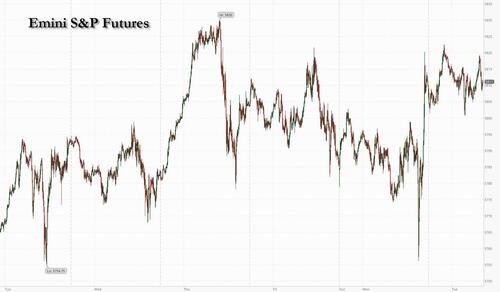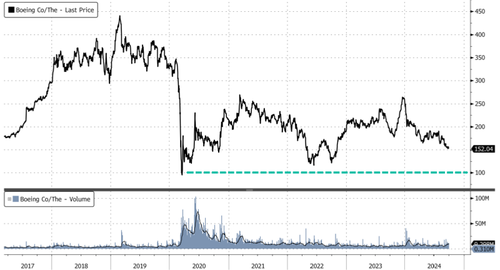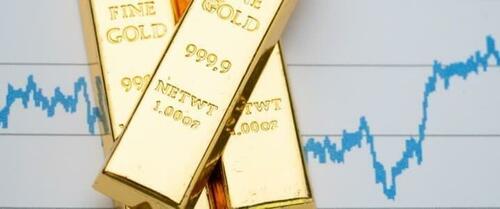US equity futures are down a touch as we enter Q4 after trading overnight in a narrow range, with NDX leading and RTY lagging, a familiar pattern from the first half of the year. So far in 2024, S&P is +20.8%, NDX +19.2%, and RTY +10.0% (a full YTS performance return in a latter post). As of 8:00am ET,. S&P futures are down 0.1% after the index notched a fresh record Monday, the 43rd of the year, following a third-quarter rally that capped the longest such winning stretch since 2021; Nasdaq futs are unchanged with Mag7 names mixed as Semis hold a slight bid. FTSE +35bps, CAC -20bps, DAX +30bps, Nikkei +1.93%, the record China market juggernaut (Hang Seng/Shanghai) is closed for the next week due to holidays. Bond yields are lower as the yield curve bull steepens, and USD is higher. Commodities are mixed with Ags/Energy under pressure and Precious Metals are leading Base metals. Overnight news focused on Israel “targeted ground raids” into Lebanon (Israeli security official said a wider operation into Beirut is not on the table) and the US Dockworkers strike starting on the East Coast with economic costs estimated to be up to $5bn/day; hurricane recovery continues in the Southeast. Today’s macro data focus is on ISM-Mfg, JOLTS, Construction Spending, and Vehicle Sales. There are five Fed speakers today.

In premarket trading Boeing slips about 1% as the company is considering raising at least $10 billion by selling new stock, according to Bloomberg. Apple is down 1.5% after Barclays warns of weak demand for iPhone 16, countering JPM optimism yesterday. Marine shipping firm ZIM Integrated Shipping fell as much as 4.9% after dockworkers walked out of every major port on the US East and Gulf coasts, marking the beginning of a strike. FedEx Corp. and United Parcel Service Inc. edged higher after Stifel said they are the “most obvious beneficiaries” of disruptions caused by the strike. Here are the other notable premarket movers:
- Atlassian (TEAM) rises 2% as Raymond James turns bullish, citing growth potential for the cloud business despite a period of undershooting expectations.
- CVS Health (CVS) gains 2% as the company is conducting a strategic review of options including a possible breakup, according to a person familiar with the matter.
- IGM Biosciences (IGMS) sinks 23% after its chief executive, scientific and medical officers stepped down amid a pivot to focus exclusively on autoimmunity.
- Pennant Group (PNTG) declines 2% after the health-care company launched a 3.5 million share offering to repay debt.
A global bond rally got fresh fuel Tuesday from data that euro-area inflation has been mostly vanquished, emboldening bets on interest-rate cuts. Treasuries advanced, while yields on 10-year German bonds fell as much as seven basis points to the lowest level since January. Optimism that the Fed can engineer the elusive “soft landing,” restricting policy but not so much that it chokes off growth, helped drive rallies in both bond and stock markets in the third quarter as markets are pricing in a recessionary 200bps in cuts which however is viewed as good for stocks. Indeed, money markets imply a one-in-three chance the Fed will deliver another half-point cut in November, and price a total of about 190 basis points of easing by the end of next year. That scenario may not pan out as expected, Larry Fink warned.
“The amount of easing that’s in the forward curve is crazy,” Fink, the chief executive officer of BlackRock Inc. said in an interview with Bloomberg TV. “There’s room for easing more, but not as much as the forward curve would indicate.”
European markets rise, with the Euro Stoxx 600 up 0.4% near session highs. FTSE 100 outperforms peers, adding 0.3%, IBEX lags, dropping 0.3%. Tech, real estate and travel are the strongest performing sectors. Euro-area inflation slowed below the European Central Bank’s 2% target for the first time since 2021, prompting money markets to add to bets on another quarter-point decrease by the ECB this month. Earlier, ECB President Christine Lagarde said the bank is becoming more optimistic about getting price pressures under control.
Earlier in the session, Asian stocks edged higher in thin trading on Tuesday, with a number of major markets including China, Hong Kong and South Korea closed for a holiday. The MSCI Asia Pacific Index was up about 0.2%. Japanese stocks recouped some of their losses from the previous day, when benchmarks were down more than 3%, thanks to a weaker yen. Australian stocks slipped. The outlook for Japanese equities has become uncertain as investors digest policy signals from new Prime Minister Shigeru Ishiba’s cabinet, as well as a potential fund rotation given China’s outperformance. Also boding well for the region’s outlook is a strong rally in Chinese stocks on the back of government measures. Any spillover to the rest of the region this week may be limited as the mainland Chinese market is closed for the Golden Week holiday.
“For China, the recent re-rating has been driven by the rising belief in a PBOC/government put option supporting shares off a low base,” Macquarie strategists including Eugene Hsiao wrote in a note. “Structural concerns on China remain unchanged, but in a one-party system, a little love to the markets can go a long way”
Mfg PMIs in Europe were mostly still in contractionary (Italy worse, Germany/EZ/Spain/France better/UK in-line). EZ CPI printed in-line (1.8%) and below the ECB target since the first time since June ’21. Japan Aug unemployment was slightly lower vs consensus (2.5 vs 2.6%).
ISM preview: ISM manufacturing index expected to tick up to 47.6 in September from 47.2 in August but remain in contraction. New orders component likely to get some additional scrutiny after falling to weakest level since May 2023 in the last print.
In FX, the Bloomberg Dollar Spot Index rises 0.2% while the euro falls as euro-area inflation slowed below the ECB’s 2% target for the first time since 2021. AUD and JPY are the best performers in G-10 FX; NOK and NZD underperform.
In rates, treasuries were underpinned by gains for core European rates after euro-area inflation slowed below the European Central Bank’s 2% target for the first time since 2021. Yield curve is notably flatter led by similar price action in bunds. US yields are richer by 2bp to 5bp across the curve near session lows with 2s10s, 5s30s spreads flatter by 1bp-2bp on the day; 10-year around 3.74% is down about 4bp vs Monday’s close with bunds and gilts in the sector outperforming by 3.5bp and 2bp. German bonds rally across the curve, led by the long end, while also outperforming comparable 10-year gilts and Treasuries. Bull-flattening rally in bunds has German 2s10s, 5s30s spreads flatter by 4bp and 3bp on the day with 10-year German yields remaining down around 8bp at ~2.05%. US session highlights include ISM manfacturing data and JOLTS job openings, along with several Fed speakers.
In commodities, concerns of oil oversupply as Libya is set to restore production weighs on prices. While they’ve trimmed some losses, WTI and Brent are down on the day. Spot gold climbs roughly $14 to trade near $2,649/oz on haven demand amid rising tensions in the Middle East.
Looking at today’s calendar, US economic data calendar includes September final S&P Global US manufacturing PMI (9:45am), August construction spending and JOLTS job openings and September ISM manufacturing (10am) and September Dallas Fed services activity (10:30am). Fed speakers scheduled include Bostic (11am, 11:10am, 6:15pm), Cook (11:10am), Barkin and Collins (6:15pm)
Market Snapshot
- S&P 500 futures little changed at 5,810.75
- STOXX Europe 600 up 0.2% to 523.97
- MXAP up 0.2% to 195.43
- MXAPJ down 0.3% to 619.11
- Nikkei up 1.9% to 38,651.97
- Topix up 1.7% to 2,690.78
- Hang Seng Index up 2.4% to 21,133.68
- Shanghai Composite up 8.1% to 3,336.50
- Sensex little changed at 84,291.28
- Australia S&P/ASX 200 down 0.7% to 8,208.93
- Kospi down 2.1% to 2,593.27
- German 10Y yield little changed at 2.06%
- Euro down 0.2% to $1.1115
- Brent Futures down 1.8% to $70.40/bbl
- Gold spot up 0.4% to $2,644.96
- US Dollar Index up 0.15% to 100.93
Top Overnight News
- Dockworkers have walked out of every major port on the US East and Gulf coasts, marking the beginning of a strike that could ripple through the world’s largest economy and cause political turmoil just weeks before the presidential election.
- Macau’s gaming revenue rose 15.5% year-on-year in September, exceeding analysts’ forecast as casinos gear up for one of China’s biggest holidays, which usually fuels travel to the gambling hub. Gross gaming revenue reached $2.2 billion. The result is compared to the median analyst estimate of a 14.2% increase, and has returned to 78% of the pre-pandemic level seen in 2019. BBG
- BOJ board members meeting in September highlighted the need to enhance communications with financial markets, while some members stressed the importance of staying wary of downside risks. “When conducting further policy interest rate hikes, the bank will need to communicate its policy stance and other factors to markets more carefully,” one of nine policy board members said at the September 19-20 meeting. BBG
- Euro-area CPI rose 1.8% in September year on year as expected, dipping below the 2% target for the first time since 2021 and bolstering the case for an ECB rate cut this month. The euro slipped. BBG
- Israel launched a ground operation in Lebanon, escalating its battle against Hezbollah. Troops began what Israel said were “targeted” raids on villages close to the border and emphasized operations would be “limited.” The US said it “agreed on the necessity of dismantling attack infrastructure.” BBG
- VP nominees JD Vance and Tim Walz face off at 9 p.m. ET for their first and potentially only debate before the election. The presidential candidates themselves also offer strikingly different visions of the economy. BBG
- Consumers plan to boost their holiday spending by ~7% according to a new study from PwC, but retail industry price competition will be intense. BBG
- CVS Health is conducting a strategic review of options for the company, including a possible breakup of the industry giant, according to people with knowledge of the matter. WSJ
- BlackRock CEO Larry Fink said the market is pricing “crazy” levels of Fed rate cuts given the US economy continues to grow. BBG
- Michel Barnier will face France’s parliament for the first time as prime minister on Tuesday to deliver a make-or-break speech outlining how he plans to regain control of public finances while navigating bitter divisions between lawmakers.
- Hurricane Helene has killed more than 100 people in six states across the US South — and most of the victims lived hundreds of miles away from where the storm made landfall.
A more detailed look at global markets courtesy of Newsquawk
APAC stocks began the new quarter mixed amid a slew of data releases and several key market closures with markets in Mainland China, Hong Kong and South Korea closed, while participants also reflected on Fed chair Powell’s recent comments and Israel’s ground offensive in Lebanon. ASX 200 was pressured as underperformance in the mining, materials and financial sectors overshadowed the resilience in tech and defensives, while data releases were mixed as Retail Sales topped forecasts but Building Approvals showed a sharper-than-feared contraction. Nikkei 225 rallied after the recent heavy selling with the recovery facilitated by a weaker currency amid mixed Tankan data and varied BoJ opinions.
Top Asian News
- BoJ Summary of Opinions from the September meeting stated that a member said there is no change to the stance of adjusting the degree of monetary support if the economy and prices move in line with forecast although they must be vigilant to factors behind still unstable markets, while there was an opinion from a member that there is no need to raise rates when markets are unstable because they are not behind the curve on inflation and a member also said that given economic and market uncertainties, it is undesirable to make further changes to policy rate in a way that give markets impression they are moving to full-fledged policy tightening. Furthermore, a member said there is no change to the view that the BoJ must raise rates without waiting too long, but the rate hike must not be purpose in itself, while a member also thought that the rate path should move policy rate to 1.0% in the latter half of fiscal 2025 at earliest.
- Japan’s newly appointed Finance Minister Kato says he has been instructed to promote a growth-orientated economy driven by wage increases and investment, via Jiji.
- Japan’s newly appointed Economy Minister Akazawa says he wants the BoJ to decide on future rate hikes carefully; Taking Japan completely out of deflation is the top priority.
European bourses, Stoxx 600 (+0.2%) began the session around flat, but quickly dipped lower as sentiment took a hit early in the morning; a move which has since stabilised. As it stands, indices in Europe are mixed and trade very modestly on either side of the unchanged mark. EZ Manufacturing PMI/HICP figures passed through with little impact on price action. European sectors hold a slight positive bias, but with the breadth of the market fairly narrow. Tech takes the top spot alongside strength in Travel & Leisure. Energy is found at the foot of the pile, given the continued weakness in oil prices. US Equity Futures (ES -0.1%, NQ U/C RTY -0.3%) are mixed, with slight underperformance in the economy-linked RTY as traders continue to digest remarks from Fed Chair Powell who pushed back against another oversized cut in 2024.
Top European News
- Deutsche Bank now expects an ECB cut in October and believes a 50bps move in December could be a close call if recent weaker growth and inflation trends continue.
- ECB’s de Guindos says expectations surveys are an important part of the toolkit available to central banks for their policy analysis.
- ECB’s Rehn sees EZ inflation stabilising at 2% during 2025; direction of monetary policy is clear – rate cuts have begun; stance is becoming less restrictive; pace and scale of cuts decided meeting-by-meeting. Draghi report is a necessary wake-up call about Europe’s low growth and will provide good bases for next commission work programme. EZ growth could be weaker than forecast. In his view, there are now more reasons to justify a rate cut in October; recent weakening of EZ growth outlook also tips the scale in direction of an October cut
- ECB’s Nagel says that future purchases of government bonds by the European Central Bank should be reserved for special cases, according to Bloomberg.
- French PM Barnier is planning to announce additional tax increases of EUR 15-18bln in an attempt to gain back control of the nation’s finances, according to Le Parisien. To speak at 14:00BST/09:00ET
- Riksbank minutes (September meeting): Thedeen said; “The fact that we explicitly state in the draft report that we may make cuts in larger steps is a clear indication that, given the favourable inflation outlook, this is now part of our gradual monetary policy strategy”. “Krona remains undervalued and our inflation forecast is based on the assumption of a gradual appreciation of the exchange rate”.
FX
- DXY is building on the gains seen yesterday that were driven by comments from Fed Chair Powell. DXY has briefly made its way onto a 101 handle, topping out at 101.04.
- EUR/USD is on the backfoot vs. the USD as the post-Powell USD buying has dragged the pair lower. Today’s in-line EZ HICP metrics provided little follow-through into the EUR given soft regional prints ahead of the release.
- GBP is softer vs. the broadly firmer USD as Cable extends its move further south of the 1.34 mark, taking out its 10DMA at 1.3338 in the process.
- After a soft start to the session, which looked to be a continued fall out from the post-Powell USD buying, JPY has been able to regain some poise vs. the USD after the pair topped out at 144.53.
- AUD/USD is currently straddling the 0.69 mark after yesterday’s Powell-induced selling pressure dragged the pair away from its 0.6942 YTD peak. For now, the pair is holding above yesterday’s low at 0.6894 with Retail Sales overnight offering some support. NZD/USD is holding just above the 0.63 mark
- BNZ forecasts a 50bps at the October RBNZ policy announcement.
Fixed Income
- USTs are firmer and back to pre-Powell levels after the marked bear-flattening the Chair induced on Monday evening. USTs to a 114-21 peak, approaching Monday’s best which itself is a tick below Friday’s 114-25 peak. Docket ahead is headlined by Final Manufacturing and then, more pertinently, the ISM Manufacturing PMI before remarks from Barkin, Bostic & Cook.
- EGBs are firmer, lifted by the Final PMIs as while there were modest upward revisions the overall growth-narrative remains weak and factors in favour of the doves who are considering an October cut; EZ CPI printed largely in-line, and had no impact. Bunds to a 135.72 peak, which has eclipsed the August 135.66 best for a new contract high.
- Gilts are at a 99.15 peak with supply strong but spurring no move ahead of remarks from Chief Economist Pill this afternoon. BoE’s Greene spoke overnight and noted that she is attentive to any sign that firms could begin passing on higher costs if consumption rebounds strongly. Today’s Manufacturing PMI data for the UK was unrevised.
- UK sells GBP 2.25bln 4.75% 2043 Gilt: b/c 3.27x (prev. 3.37x), average yield 4.421% (prev. 4.372%) & tail 0.1bps (prev. 0.2bps)
- Germany sells EUR 3.301bln vs exp. EUR 4bln 2.50% 2029 Bobl: b/c 1.9x (prev. 2.2x), average yield 1.9% (prev. 2.17%) & retention 17.48% (prev. 16.25%)
Commodities
- Subdued trade in the crude complex as the China optimism loses steam (against the backdrop of a cautious risk tone) and with the complex largely ignoring recent geopolitical developments. Do note, Libyan supply is slated to resume today after the dispute between eastern and western factions was settled. Brent’Dec sits just off today’s trough, with the range for today is USD 69.91-71.97/bbl parameter.
- Precious metals are modestly firmer despite the stronger Dollar but amidst the backdrop of escalating geopolitics. XAU sits in a current USD 2,633.31-2,647.51/oz parameter.
- Base metals are somewhat muted/mixed as the complex takes a breather from the recent China-induced gains and in the run-up to risk events including ISM Manufacturing today and NFP on Friday. As a reminder, Chinese markets will be away for the rest of the week amid Golden Week Holiday.
- US buys 6mln bbls of oil for SPR with 1.5mln bbls of oil per month for delivery from February to May 2025, according to the Energy Department.
- Chevron (CVX) reports unplanned flaring at its 290k BPD El Segundo California refinery, according to a community alert.
- BofA retain their bullish call on gold and see yellow metal hitting USD 3000/oz next year. Copper at USD 12,000/t or USD 5.44/lb in 2026
Geopolitics: Middle East
- “Al-Arabiya correspondent: Lebanese army deployed in the Bekaa”, according to Al Arabiya.
- “Israel Broadcasting Corporation quoting an Israeli official: The scale of ground operations in Lebanon could change”, according to Sky News Arabia.
- Israel Security Official says Israeli ground operation is limited, and a wider operation targeting Beirut is “not on the table”; no clashes with Hezbollah reported yet on the ground.
- “Al-Arabiya sources: The Israeli army plans to incursion into Lebanon from 1 to 2 km in the first phase”, according to Al Arabiya
- Israeli military said it began limited, localised and targeted raids against Hezbollah targets in the border area of southern Lebanon, while it said the targets are located in villages near the border and pose an immediate threat to northern Israeli communities. Furthermore, Axios reported that officials also confirmed that the Israeli ground operation in southern Lebanon has started.
- An Israeli strike was reported on a building in Ain Al-Hilweh Palestinian Camp near Lebanon’s Sidon and Lebanese sources noted an Israeli raid targeted the house of Major General Munir Al-Maqdah inside the Ain al-Hilweh camp, according to Sky News Arabia.
- Israel informed Washington it is planning a limited ground operation in Lebanon that could start imminently, according to the Washington Post. Furthermore, a senior US official told Fox that Israel will launch a “limited” ground incursion into South Lebanon, while the official added that an incursion is imminent and will be smaller in scale than in 2006 and last a shorter period of time.
- Israeli Security Cabinet approved the war’s next phase and ministers slammed US leaks about ground operations, according to Times of Israel.
- Hezbollah said it is countering Israeli ground military movements and it targeted Israeli troop movements across from Lebanese border towns.
- Israel’s Channel 12 reported that about 10 rockets were fired from Lebanon and landed in open areas in Miskaf in northern Israel, according to Sky News Arabia. It was separately reported that the IDF said it monitored the launch of 3 rockets from Lebanon towards Safed and it intercepted two rockets while the other landed in an open area, according to Al Jazeera.
- Syrian state media reported that explosions were heard over Syria’s capital Damascus with Syrian air defences intercepting hostile targets.
- Yemen’s Houthis said they will escalate military operations in response to Israeli attacks.
- Media outlets close to the Houthis noted talk about the Houthis launching a ballistic missile towards Tel Aviv, according to Sky News Arabia. Israel’s Channel 12 reported shortly after that residents in central Israel heard an explosion in the Tel Aviv area.
- A military base hosting US forces near Iraq’s Baghdad International Airport was targeted by a rocket attack.
- Yemeni Houthi spokesperson says group targeted Israeli military posts in Tel Aviv and Eilat with drones.
Geopolitics: Other
- Russia’s Deputy Foreign Minister says Russia are ready for a long confrontation with the US; They send all necessary warnings.
- North Korea criticised the US deployment of nuclear assets in South Korea with a US B-1B bomber potentially to participate in a planned military parade on Tuesday.
US Event Calendar
- Sept. Wards Total Vehicle Sales, est. 15.7m, prior 15.1m
- 09:45: Sept. S&P Global US Manufacturing PM, est. 47.0, prior 47.0
- 10:00: Aug. JOLTs Job Openings, est. 7.67m, prior 7.67m
- 10:00: Aug. Construction Spending MoM, est. 0.2%, prior -0.3%
- 10:00: Sept. ISM New Orders, prior 44.6
- Prices Paid, est. 53.5, prior 54.0
- Manufacturing, est. 47.5, prior 47.2
- ISM Employment, prior 46.0
- 10:30: Sept. Dallas Fed Services Activity, prior -7.7
Central Banks
- 11:00: Fed’s Bostic Gives Opening Remarks
- 11:10: Fed’s Bostic Moderates Conversation with Lisa Cook
- 18:15: Fed’s Bostic, Barkin, Collins on Moderated Panel
DB’s Jim Reid concludes the overnight wrap
Welcome to Q4. As it’s the start of the quarter, we’ll shortly be publishing our usual performance review for Q3 (and September), covering how various financial assets fared. Markets put in a strong overall performance, despite the turmoil in early August, and as it stands, the S&P 500 has now posted its strongest YTD advance of the 21st century so far up to Q3, having advanced more than +20% since the start of the year. Other Q3 highlights include the strongest advance for the Japanese Yen since Q4 2008, whilst US Treasuries are up for a 5th consecutive month for the first time since 2010. See the full report in your inboxes shortly.
When it came to the last day of the month, markets outside of China which had the best day since September 2008 on Monday, saw a mixed day. Europe was down heavily and the US stumbled a little following some less dovish comments from Fed Chair Powell, but positive month-end effects late in the session helped the S&P 500 (+0.42%) post its 43rd all-time high of the year.
Powell’s remarks led to some doubts over whether the aggressive pace of the easing cycle priced by markets would materialise. While maintaining data-dependence, he emphasised that the economy remains solid, noting that “this is not a committee that feels like it’s in a hurry to cut rates quickly”. He also reiterated the rates signal from the most recent SEP, saying that “if the economy performs as expected that would mean two more cuts this year, for a total of 50bps more”. So some conditional pushback relative to market expectations that had moved to fully price 75bps of further cuts by year-end.
In response, Fed funds futures tempered the rate cut expectations, with the amount of easing priced by December falling to 70bps, down from 77bps at the start of the day and 73bps before Powell spoke. Off the back of this, Treasury yields extended what had been a modest increase earlier in the day, with 2yr Treasury yields closing +8.2bps higher on the day at 3.64%, while 10yr yields were up +3.0bps to 3.78%.
US equities were briefly weighed down, with the S&P 500 falling by as much as -0.6% following Powell’s comments, but recovered to post yet another record high (+0.42% on the day). This came amid a sharp move in the final 30 minutes of trading, suggesting that month- and quarter-end effects were likely at play. The tech mega caps outperformed in this late rally, with the Mag-7 up around 0.8% in the final half an hour of trading to close +0.63% higher on the day.
Before Powell’s remarks, European markets had lost ground, despite growing anticipation that the ECB would be cutting rates again at their meeting in a couple of weeks’ time. Overnight DB’s European economics team have added a cut at this meeting into their forecast with back-to-back cuts out to neutral (2.00-2.50%) by mid-2025 with risks skewed towards a 50bps in December. See their piece here.
The increased October cut talk was initially driven by the latest German inflation data, where the EU-harmonised measure was down to +1.8% in September as expected. That’s the first sub-2% reading since February 2021, so it helped cement the view that the ECB was well on the way to getting inflation durably back to target. Similarly, the Italian data showed inflation down to just +0.8%, although it’ll be the Euro Area-wide release today that ultimately matters for the ECB’s decision.
After the inflation data, we then heard from ECB President Lagarde, who kept the door open to an October cut in her latest comments to the European Parliament’s Committee on Economic and Monetary Affairs. In her prepared remarks, she said that “inflation might temporarily increase in the fourth quarter of this year as previous sharp falls in energy prices drop out of the annual rates, but the latest developments strengthen our confidence that inflation will return to target in a timely manner. We will take that into account in our next monetary policy meeting in October.” That explicit mention of October raised investors’ hopes that the ECB were considering whether to cut once again, and overnight index swaps dialled up the likelihood of an October cut from 82% on Friday to 91% by the close last night.
Despite the mounting rate cut anticipation for October, sovereign bond yields saw little change in Europe yesterday, as investors’ expectations for rate cuts further out into 2025 didn’t see a similar dovish shift. Indeed by the close, yields on 10yr bunds (-1.0bps) were only slightly lower, and those on 10yr OATs (-0.3bps) and BTPs (+0.2bps) were little changed. And for equities there were more consistent losses, with the STOXX 600 (-0.98%) falling back from its all-time high on Friday, whilst the CAC 40 (-2.00%) posted its worst daily performance since August 1.
Asian equity markets are mixed and much quieter this morning with China starting a week long holiday and some other markets closed. The Nikkei is up +1.91% as I type, supported by a weaker yen, after a significant drop of nearly -5% in the previous session, following Shigeru Ishiba’s win in the Liberal Democratic Party’s leadership race on Friday, given they are seen as a monetary hawk. In contrast, the S&P/ASX 200 is down by -0.82%, reversing its previous gains after hitting an all-time high yesterday. US futures are pretty flat along with US Treasuries.
Early morning data showed that retail sales in Australia rose +0.7% m/m in August (v/s +0.4% expected) as unusually warm weather brought forward spring spending. This follows an upwardly revised increase of +0.1% in July. Separately, Japan’s unemployment rate dropped to 2.5% in August (v/s +2.6% expected) against a level of +2.7% the previous month. Also, the jobs-to-applicants ratio in August declined to 1.23 from 1.24 in July. The Bloomberg forecast was for 1.24. Meanwhile, business optimism among large Japanese manufacturers remained steady at +13, unchanged from the quarter before. Separately, sentiment among large non-manufacturers improved, rising to +34 from +33 in the second quarter, beating market expectations of +32. So a big data dump in Japan that was generally slightly positive.
There wasn’t too much other data yesterday, although UK mortgage approvals picked up to 64.9k in August, which is their highest level since the month of the mini budget in September 2022. Separately, Q2 GDP growth was revised down a tenth to +0.5%.
To the day ahead now, and from the US we’ll get the ISM manufacturing for September, as well as the JOLTS job openings for August. Otherwise, there’s the global manufacturing PMIs for September, and the Euro Area flash CPI release for September. Central bank speakers include the Fed’s Bostic, Cook, Barkin and Collins, ECB Vice President de Guindos, the ECB’s Nagel, Rehn and Schnabel, and the BoE’s Pill. Today’s earnings releases include Nike. And in the political sphere, there’s a US election debate between the Vice Presidential candidates and French PM Barnier will give a policy speech and likely give clues to the latest on a difficult budget negotiation.









